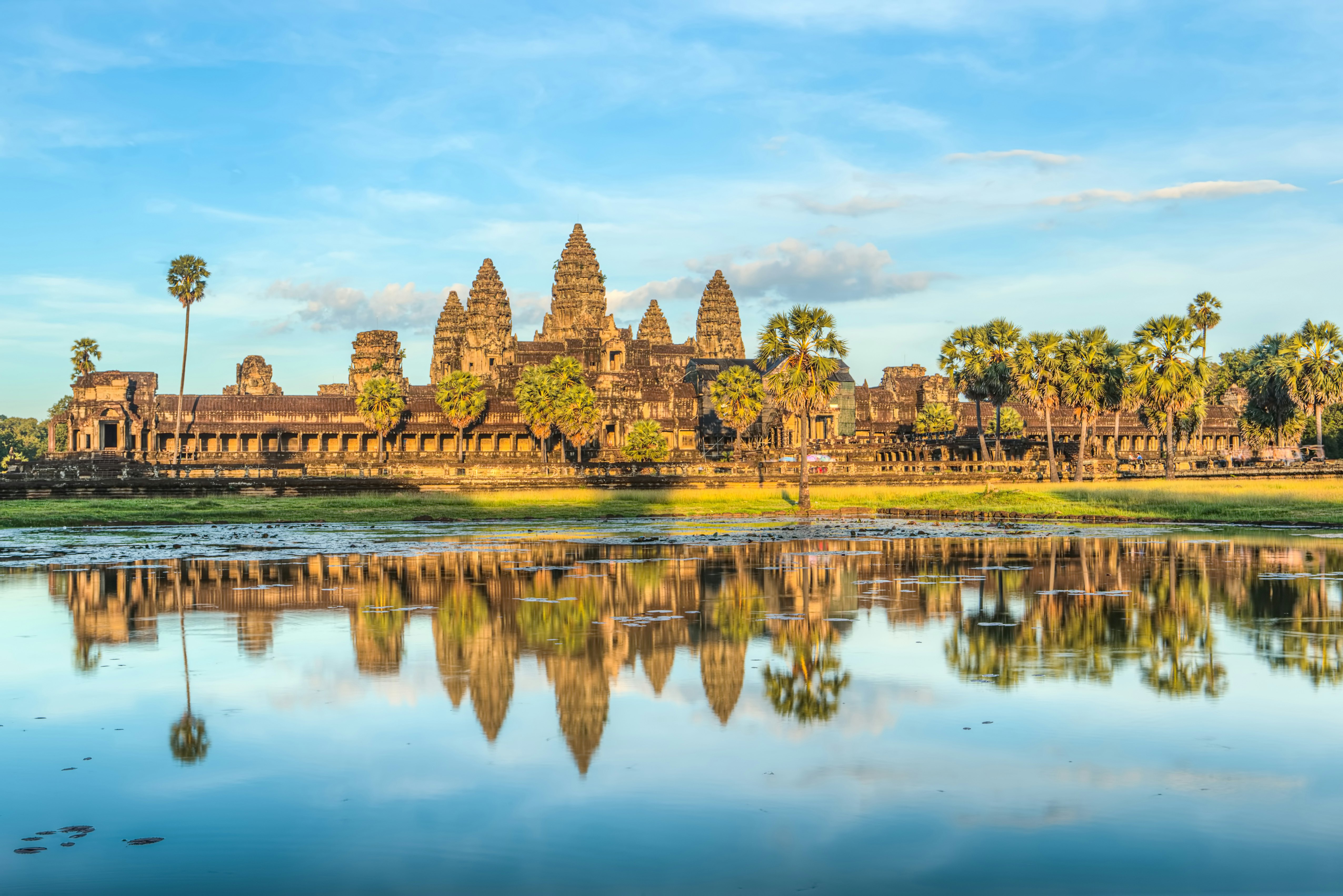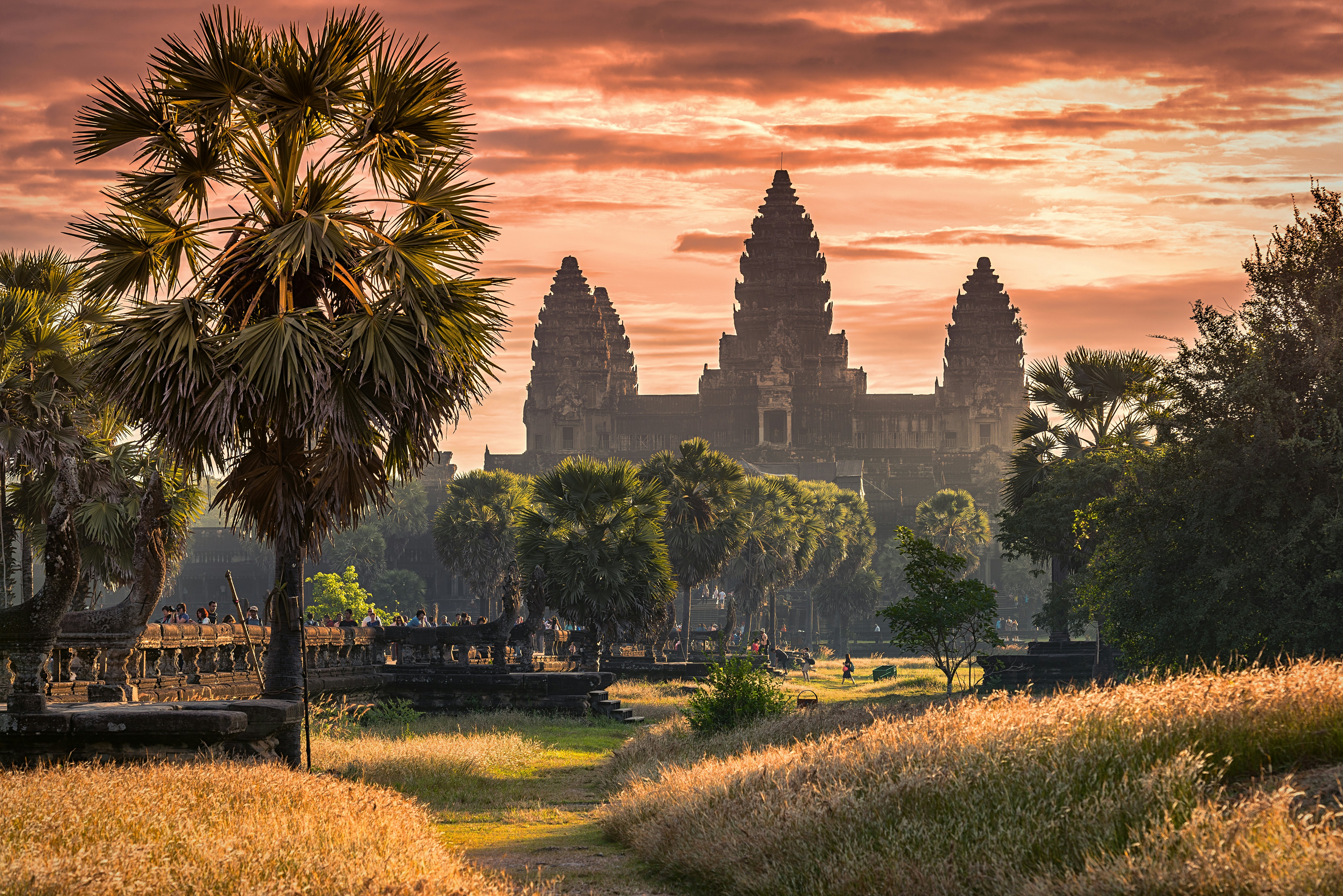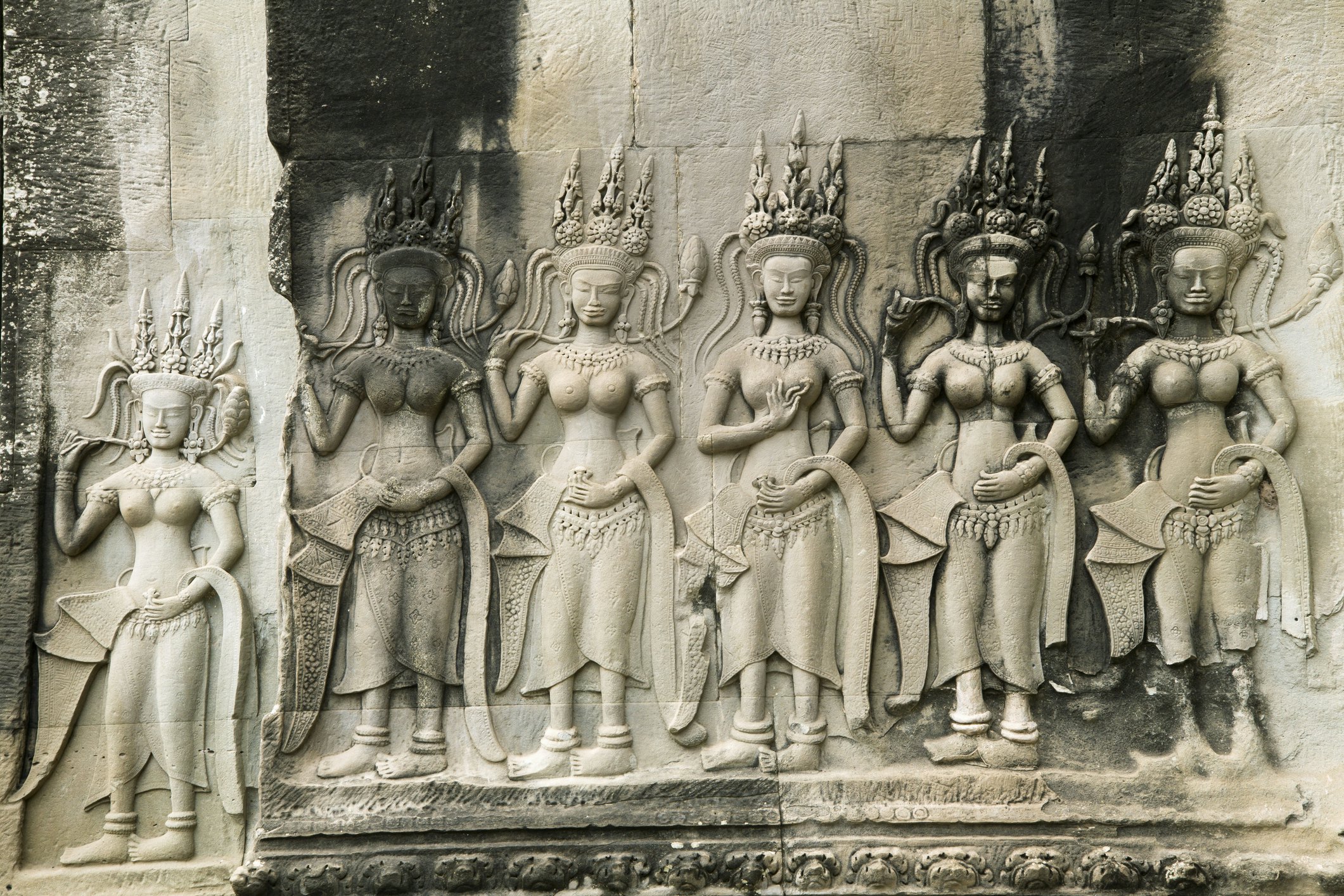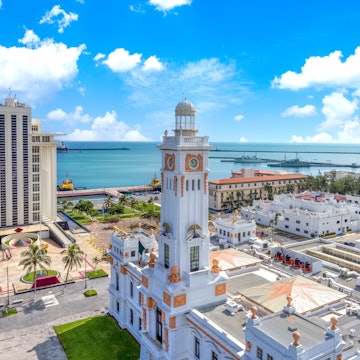
Everything you need to know about Angkor Wat, Cambodia's most iconic temple

Jan 9, 2025 • 9 min read

Few monuments in the world are as instantly recognizable as Angkor Wat. Waj/Shutterstock
In the 12th century, the ancient Khmer kings of Cambodia packed the equivalent of all of Europe’s great cathedrals into an area the size of Los Angeles, making the fabled Temples of Angkor a veritable Disneyworld for history enthusiasts.
These majestic temples in northwest Cambodia are listed as a UNESCO World Heritage site, topping the history hit list for many travelers to Southeast Asia. The ultimate statement of Khmer architectural ingenuity, Angkor Wat is the largest religious building in the world and a perfect blend of religious symbolism and symmetry.
The temple is the heart and soul of Cambodia and a source of fierce national pride – amongst other things, this is the only building featured on a national flag. Almost every inch of this immense complex is covered with intricate carvings and motifs and there's a huge amount to see, so it pays to do a little homework on this most iconic of temples before planning your bucket list adventure to Angkor.
To point you in the right direction, here's Lonely Planet's ultimate guide to Angkor Wat.

Angkor Wat practicalities
Before you book your ticket to Cambodia, give some thought to the practicalities of visiting this ancient temple complex. The weather, the tourist season and the logistics of exploring such a vast site are all things to consider.
When should I go to Angkor Wat?
It is possible to visit Angkor Wat at any time of year, but the peak season runs from November to February, when the weather is drier and cooler, although it’s still plenty hot enough for most visitors. The best time of day to visit the site is at sunrise when it’s cooler, though you can still expect the temple to be crowded.
To explore when the temple is quieter, come at lunchtime when most of the tour groups are in town. Sunset is another popular time to visit, when the temple appears to glow softly in the warm light of the late-afternoon sun. Be aware that Angkor Wat closes soon after at 6pm, and the site is not currently open at night.
If you're ready for an early start, Angkor Wat opens at 5am for visitors who want to see the sunrise from this iconic spot. Note however that the upper level, known as the Bakan Sanctuary, is only open from 7:30am.
How much time should I spend in Angkor Wat?
Allow at least three hours to explore the vast complex that is Angkor Wat, or set aside half a day if you want to see every nook and cranny. Many visitors arrive early for sunrise and then stick around to explore while temperatures are cooler, between the hours of 6am and 9am.
Don’t forget that Angkor is much more than its namesake wat (temple). More than 70 spectacular temples lie scattered around Angkor Wat, such as the Bayon, with its vast carved faces of the Buddhist deity Avalokiteshvara, and the "Tomb Raider temple" of Ta Prohm.
Tickets to the Angkor complex – including Angkor Wat and dozens of surrounding temples – are valid for one day (US$37), three days (US$62) or one week (US$72). You'll have no problems filling at least three days exploring the highlights.

How much money do I need for Angkor Wat
At first glance, the entry fee for Angkor Wat might seem steep by Cambodian standards, but keep in mind that this also includes access to Angkor Thom, the Bayon, Ta Prohm, Preah Khan, Banteay Srei and a host of other world-class temples that are among the most impressive ancient monuments in Asia.
We definitely advise going for the 3-day pass, which can be used over the course of a week, so you can pace your visits to these epic monuments. General living costs in Siem Reap, the dormitory town for Angkor Wat, are very reasonable, with good value accommodation and plenty of cheap eats and drinks.
Debit cards, credit cards and electronic payments are now widely accepted in Cambodia, and you can use these to purchase your Temples of Angkor pass, either on arrival in Siem Reap or online via the official website. Here's an overview of key costs on a trip to Angkor.
Hostel room in Siem Reap: US$5–15
Boutique hotel room in Siem Reap: US$50–150
Bottle of Cambodia beer at a bar: US$1–3
Cup of French-style coffee: US$1–3
Bowl of kyteow (noodle soup): US$2–3
Dinner for two at a local restaurant: US$10–20
Temples of Angkor pass: US$37/62/72 for 1/3/7 days
Local tour guide for Angkor Wat: US$30–40 per day
Tuk-tuk for visiting Angkor Wat: US$15–20 per day
Bicycle rental: US$2–10 per day

Is it easy to get around at Angkor Wat?
Served by flights from around Southeast Asia, Siem Reap-Angkor International Airport (SAI) is the global gateway to Angkor Wat, located about 44km from both Angkor Wat and Siem Reap. A taxi from the airport to town costs US$35 one-way, or there's a regular shuttle bus for US$8 per person. Buses and minivans connect Siem Reap with other popular destinations in Cambodia, including Phnom Penh and Battambang, plus Bangkok in Thailand.
When it comes to local transport from Siem Reap to Angkor Wat, you can choose from rental motorbikes (good for one or two people), remork-motos (tuk-tuks) that fit two to four passengers, and private cars or minivans for families or small groups.
Eco-friendly options for exploring include rented mountain bikes and electric bicycles – there's a new cycling path that connects the town of Siem Reap with Angkor Wat and other key temples. Guided tours can also be arranged through hotels and tour operators in Siem Reap.

Top things to do in Angkor Wat
Getting your first glimpse of Angkor Wat – the ultimate expression of ancient Khmer genius – is matched by only a few select sites on earth such as Machu Picchu and Petra. Angkor Wat has the epic proportions of the Great Wall of China, the detail and intricacy of the Taj Mahal and the symbolism and symmetry of the Great Pyramid at Giza all rolled into one.
The vast moat would make most European castles blush. It rings a huge rectangular compound measuring 1.5km by 1.3km (0.9 miles by 0.8 miles). To the west, a sandstone causeway crosses the moat, leading the faithful into the sacred temple grounds.
Angkor Wat also replicates the spiritual geography of the universe in miniature. The central tower represents Mt Meru, the Mt Olympus of the Hindu faith and the spiritual home of the gods, while the moat represents the oceans. The seven-headed naga (mythical serpent) that guards the causeway is a symbolic bridge for humankind to reach the abode of the gods.
Decipher Angkor Wat's ornate bas-reliefs
Visitors to Angkor Wat are first struck by its imposing grandeur and then, at close quarters, by its fascinating decorative flourishes. Stretching around the outside of the central temple complex is an 800m-long (2624ft) sequence of incredible bas-reliefs, with intricate carvings depicting historical events and stories from Hindu mythology. The most famous of these are panels showing the Churning of the Ocean of Milk – the ancient Hindu creation story – and a frieze featuring Suryavarman II and his all-conquering armies on the march.

Spot the temple's heavenly angels
Angkor Wat is famous for having some 2000 beguiling apsaras (celestial nymphs) carved into its walls. Each of them is unique, and there are 37 different hairstyles for budding stylists to check out. Many of these exquisite carvings were damaged during efforts to clean the temples with chemicals during the 1980s, and bat urine and droppings have also degraded the carvings over time, but they are being restored by teams from the German Apsara Conservation Project.
Ascend to the Bakan Sanctuary
The stairs to the upper level of the temple are deliberately steep – reaching the kingdom of the gods was never meant to be an easy task! Also known as the Bakan Sanctuary, the upper level of Angkor Wat is open to a limited number of visitors per day, with a strict queuing system.
At the summit, four Buddha images stand in the doorways of the central tower, showing the temple's transition from Hinduism to Buddhism under King Jayavarman VII. From this elevated position, there are impressive views across the vast temple compound and surrounding forest.
My favorite thing to do in Angkor Wat
One of the best ways to escape the crowds at Angkor Wat is to enter via the "back door" on the east side of the temple before sunrise. As you walk through the forest, alive with the sounds of cicadas and birdsong, the shadowy outline of this world wonder is barely visible against the dark sky.
Bring a torch (flashlight) and shine it towards the lower level to bring epic carvings alive from the darkness. Then succumb to temptation and join the masses for the main event – which is watching sunrise from the western side of the temple.

Learn more about Angkor Wat
You'll gain more from a visit to Angkor Wat if you read up on how this magnificent monument was built, and why.
Who built Angkor Wat?
Oriented toward the west, Angkor Wat was built by King Suryavarman II, who reigned from 1113 to 1150 BCE, but the temple was never finished during his lifetime. In Hindu culture, west is the direction symbolically associated with death, which once led scholars to conclude that Angkor Wat must have existed primarily as a tomb, given that most Khmer temples are aligned facing east.
This idea was supported by the fact that the magnificent bas-reliefs were designed to be viewed in an anticlockwise direction, a practice associated with ancient Hindu funerary rites. However, the Hindu deity Vishnu is also frequently associated with the west, and it is now widely accepted that Angkor Wat served as both a temple to Vishnu and as a mausoleum for Suryavarman II.
Unlike the other Angkor monuments, Angkor Wat was never abandoned to the elements and it has been in almost continuous use since it was built. It's still a sacred site, so be sure to follow the correct etiquette when visiting.

How was Angkor Wat built?
The sandstone blocks used to construct Angkor Wat were quarried from the holy mountain of Phnom Kulen, more than 50km (31 miles) away, and floated down the Siem Reap River on rafts. The logistics of such an operation are mind-blowing – according to temple inscriptions, the construction of Angkor Wat involved 300,000 workers and 6000 elephants.
Etiquette for visiting Angkor Wat
As the temples of Angkor are a sacred religious site for the Khmer people, visitors are asked to dress modestly. It is not possible to visit the highest level of Angkor Wat unless your upper arms are covered and your legs are covered at least down to the knees.
Local authorities have produced a visitor “code of conduct” and a video to encourage appropriate dress and remind tourists not to touch, sit or climb on the ancient structures, to pay attention to restricted areas, and to be respectful of monks – view the guidelines online before you visit.













